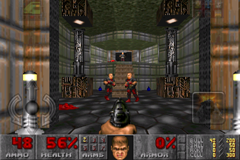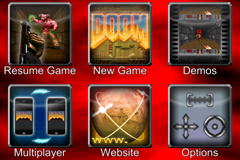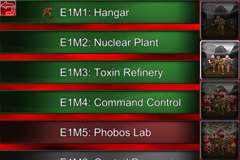iPhone Doom Classic Progress Report
By John Carmack, Technical Director, Id Software

I have been spending the majority of my time working on iPhone Doom Classic for several weeks now, and the first beta build went out to some external testers a couple days ago. I am moving back on to Rage for a while, but I expect to be able to finish it up for submission to the App Store next month.
Wolfenstein 3D Classic was a quickie project to satisfy my curiosity and test the iPhone waters, but Doom is a more serious effort. In addition to the millions of people with fond memories of the game, there is still an active gaming / development community surrounding the original Doom, and I don't want to disappoint any of them.
One of the things I love about open sourcing the old games is that Doom has been ported to practically everything with a 32 bit processor, from toasters to supercomputers. We hear from a lot of companies that have moved the old games onto various set top boxes and PDAs, and want licenses to sell them. We generally come to some terms in the five figure range for obscure platforms, but it is always with a bit of a sigh. The game runs, and the demo playbacks look good, but there is a distinct lack of actually caring about the game play itself. Making Doom run on a new platform is only a couple days of work. Making it a really good game on a platform that doesn't have a keyboard and mouse or an excess of processing power is an honest development effort.
To my surprise, Christian was able to dig up the original high quality source material for the Doom sounds, so we have 22khz 16 bit sound effects instead of the 11khz 8 bit ones from the original game. It turns out that I can barely tell the difference, which is a sign that we made good choices way back then about catering the sounds to the output device. If we were on the fence for any resource limits, I would have considered sticking with the originals, but the current OpenAL mixer code has errors with 8 bit source buffers, so I would have had to convert to 16 bit at load time anyway, and just referencing the high quality source media actually speeds up the load times.

The music is all stored as mp3, performed on a high quality synthesizer. For Wolf, we used ogg, because that's what was in the Redux codebase that I started with, but I don't have all that CPU performance margin anymore, so it was necessary to use the iPhone's audio decompression hardware through the AudioQueue services. The music is the largest part of the application, but everything else is still well over the 10 meg cellular app transfer limit, so I'm not tempted to try and squeeze it under like we did with Wolfenstein. Maybe being able to get an app over 3G really isn't very important to its success. The fact that people are downloading Myst on the iPhone is heartening -- I have ideas for leveraging our high end idTech-5 content creation pipeline for a future iPhone game, if people will go for a few hundred meg download.
The toughest question was the artwork. Since Wolf was selling well, I had planned on paying contractors to upscale all the Doom graphics to twice the original resolution. When I pulled all the graphics out and tallied it all up, it looked a lot more marginal than I had expected. There were over two thousand individual pieces of art, and it was over ten megatexels in exactly bounded area, let alone atlas fit or power of two inset. The PVRTC compressed formats would work great for the floors and ceilings, which are all nice 64x64 blocks, but it has issues for both the walls and floors.
PVRTC textures must be power of two and, notably, square. If you want a 256 x 512 texture that needs to repeat in both axis, you need to resample it to 512 x 512 to use PVRTC, which means you lose half your compression benefit and get distorted filter kernels and mip level selections. Even worse, Doom had the concept of composited walls, where a surface was generated by adding, say, a switch texture on top of a wall texture. You can't do that sort of operation with PVRTC images. The clean sheet of paper solution to both problems is to design around textures that the hardware likes and use more geometry where you need to tile or combine them, but Doom wasn't well suited to that approach.
Character sprites don't get repeated, so a lot of them can be packed into a nice square 1024 x 1024 texture to minimize waste, but the PVRTC texture formats aren't well suited to sprite graphics. The DXT1 compression format has an exact bit mask for the alpha channel, which is what you want for an application like this. PVRTC treats alpha like any other color channel, so you get coupling between the alpha and color channels that results in partially transparent pixels ringing outside the desired character boundary. It works fine for things like clouds or fireballs, but not so good for character sprites. It looks like it should be possible to get an exact binary mask with the 2 bit PVRTC mode, which could be combined with a 4 bit PVRTC color texture to get a 6 bpp perfectly outlined sprite, but the multitexture performance on the iPhone, even with PVRTC textures, is not fast enough to prevent missing 30 fps when you have a hoard of monsters in front of you.
We started to do some internal samples of up-scaled artwork to use as reference for getting the contractor quotes, and it just wasn't looking all that spectacular. Doubling the art and smoothing out the edges wasn't buying much. There was certainly a lot of room for improvement, since Doom was designed around a 256 color palette with a limited selection of intensity ramps for lighting, but moving there from the starting point would be tricky. If I went to one of our artists today and asked them to draw a bad-ass Baron of Hell throwing a fireball in a 256 x 256 x 16 bit block, I would get something a LOT better than the original art, but it would look different, not just better.

I was also a little taken aback by some of the backlash against the updated graphics that I put in for Wolf 1.1. I took the walls, guns, and decorative sprites from the Mac version of Wolfenstein, and had Eric use that as source to recreate some similar graphics that weren't present in the Mac version. After release, there were a number of reviews that complained, saying that it "ruined the classic feel". I have a couple thoughts abut this: Changing the look on a point release is going to cause some level of complaint, so it is probably a good idea to make any changes from " classic" you think you might want in version 1.0. I also believe most of the complaints were due to the view weapons. The original gun artwork wasn't great, but the double-res ones weren't very good either, and they were a bit different looking. I debated with myself a bit about using them at all, and it looks like I probably shouldn't have. I can't see any drawback whatsoever to the double res walls and sprites, since they are in the same style, just better looking when you jam your face up against them.
In the end, I decided not to do anything with the DOOM source art. With the GPU accelerated filtering and 24 bit lighting it looks a lot better than it ever did, and with floors, ceilings, and lighting you don't seem to notice the low resolution as much as with Wolf.
With the speed (a solid 30 fps, even in the more aggressive later levels), the audio, the resolution, and the rendering quality, it is Doom as you remember it, which is quite a bit better than it actually was. If you go back and play the original game on a 386 with a sound blaster, you will be surprised at the 15 fps, FM-synth music, "bathroom tile sized" 320 x 200 pixels, external network game setup utility, and external keyboard configuration. A lot of people remember it as "The best game EVER!", but "ever" has sure moved a lot in the last decade!
Before I actually started coding on the project, I had visions of adding a lot of modern tuned effects to the core gameplay experience. It would certainly stay a sprite-and-sector based game, but there are many things that would be done differently with the benefit of a GPU and the wisdom of hindsight. Once I began actually working on it, it started to look like a bad idea for a number of reasons. I am trying to not be very disruptive in the main codebase, because I want it to stay a part of prBoom instead of being another codebase fork. While I can certainly add a bunch of new features fairly quickly, iterating through a lot of user testing and checking for problems across the >100 commercial Doom levels would take a lot longer. There really is value in " classic" in this case, and there would be some degree of negative backlash to almost any "improvements" I made. There will still be a couple tiny tweaks, but nothing radical is changing in the basic play. It would be fun to take a small team, permanently fork it, and make a "Doom++" just for the iPhone, but that wouldn't be the best first move. Maybe later.
The iPhone interface around the game is all done nicely. Wolf Classic got dinged a bit for the blocky look of the buttons and interface components. I didn't actually see any complaints about the crappy monospace font, but it deserved some. Everything looks good now.
The initial release will be for OS 2.x, and support multiplayer over WiFi. A later release will be for 3.x only, and support bluetooth multiplayer. I looked into the possibility of 3G multiplayer, but the latencies just aren't good enough -- I see 380 or so pings from my phone to local servers. This was interesting, because I have talked to other hardware vendors that claim 3G latencies of half that. I'm not sure if there are issues with the iPhone, issues with AT&T's network in Dallas, or if the vendor was just mistaken about what they were getting. One anecdotal report is that iPhones work better in Japan than here, so it may be infrastructure.
I will probably have another update later with more technical details about the logic behind the new rendering architecture (rewritten for > 2x the speed of the original prBoom GL renderer), touch control issues, and so on.

